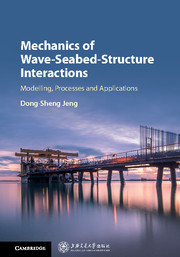Book contents
- Frontmatter
- Contents
- Preface
- 1 Overview
- 2 Basic Seabed Mechanisms
- 3 Soil Response in Marine Sediments under Combined Loading of Waves and Currents
- 4 Integrated Model of Wave-Seabed Interactions around Caisson-Type Breakwaters
- 5 Mechanics of Wave-Seabed-Pipeline Interactions
- 6 Three-Dimensional Model of Wave-Seabed Interactions around Breakwater Heads
- 7 Seabed Instability around Offshore Wind Turbine Foundations
- 8 Physical Modelling: One-Dimensional Compressive Tests
- Appendix A Analytical Solution for a Seabed of Finite Thickness (Hsu & Jeng 994)
- Appendix B Derivation of u–p Approximation (Jeng et al. 1999)
- Appendix C Derivation of u–U Approximation (Cha et al. 2002)
- Appendix D Mathematical Derivations of Analytical Solutions for Residual Soil Response (Jeng et al. 2007)
- Appendix E Mathematical Model of the Two-Layered Viscous Fluid System (Liu et al. 2009)
- References
- Author Index
- Subject Index
2 - Basic Seabed Mechanisms
Published online by Cambridge University Press: 28 April 2018
- Frontmatter
- Contents
- Preface
- 1 Overview
- 2 Basic Seabed Mechanisms
- 3 Soil Response in Marine Sediments under Combined Loading of Waves and Currents
- 4 Integrated Model of Wave-Seabed Interactions around Caisson-Type Breakwaters
- 5 Mechanics of Wave-Seabed-Pipeline Interactions
- 6 Three-Dimensional Model of Wave-Seabed Interactions around Breakwater Heads
- 7 Seabed Instability around Offshore Wind Turbine Foundations
- 8 Physical Modelling: One-Dimensional Compressive Tests
- Appendix A Analytical Solution for a Seabed of Finite Thickness (Hsu & Jeng 994)
- Appendix B Derivation of u–p Approximation (Jeng et al. 1999)
- Appendix C Derivation of u–U Approximation (Cha et al. 2002)
- Appendix D Mathematical Derivations of Analytical Solutions for Residual Soil Response (Jeng et al. 2007)
- Appendix E Mathematical Model of the Two-Layered Viscous Fluid System (Liu et al. 2009)
- References
- Author Index
- Subject Index
Summary
Introduction
Considerable efforts from researchers in the field of marine geotechnics have been devoted to the phenomenon of the wave-induced soil response since the 1970s. One reason for the growing interest is that many coastal/offshore structures (such as vertical walls, caissons, offshore monopiles and pipelines) have been damaged by the waveinduced seabed response, rather than from construction deficiencies (Christian et al. 1974; Smith & Gordon 1983; Lundgren et al. 1989).
As mentioned in Chapter 1, two mechanisms of the wave-induced soil response have been reported in the literature. Both oscillatory (transient) and residual mechanisms of the wave-induced soil response have been intensively studied since the 1970s with two different approaches: the Yamamoto–Madsen model (Madsen 1978; Yamamoto et al. 1978) for the oscillatory mechanism and the Seed–Rahman model (Seed & Rahman 1978) for the residual mechanism. Following these approaches, numerous models have been proposed in the literature. In this chapter, the basic concepts and some key results of the previous models for wave-seabed interaction will be summarised.
Oscillatory Mechanism
Basically, previous studies of the wave-induced oscillatory soil response can be classified into three categories: the Yamamoto–Madsen model, the boundary-layer approximation and the dynamic model. We outline the contribution of several key publications available in the literature here.
(a) Yamamoto–Madsen model (YM model, or Biot's consolidation model): Yamamoto et al. (1978) proposed an analytical solution for an infinite seabed with hydraulic isotropy, while Madsen (1978) derived an analytical solution for a similar problem but with hydraulic anisotropy (i.e., permeabilities in all directions are different). Different seabed conditions, such as a seabed of finite thickness (Yamamoto 1977) and a layered seabed (Yamamoto 1981), were considered. Based on the plane stress conditions, Okusa (1985b) further reduced the sixth-order governing equation in the YM model to a fourth-order governing equation. Later, the YM model was further extended to more complicated wave conditions such as three-dimensional (3D) short-crested wave systems (Hsu et al. 1993, 1995; Hsu & Jeng 1994) or seabed conditions such as cross-anisotropic soil behaviour (Jeng 1997b) or a non-homogeneous seabed profile (Jeng & Seymour 1997a; Kitano & Mase 2001). Some numerical models have been developed with this framework, which were reviewed in Chapter 1.
(b) Boundary-layer approximation: Based on the mixture theory, Mei & Foda (1981) proposed the boundary-layer approximation for the wave-induced soil response.
- Type
- Chapter
- Information
- Mechanics of Wave-Seabed-Structure InteractionsModelling, Processes and Applications, pp. 34 - 108Publisher: Cambridge University PressPrint publication year: 2018

